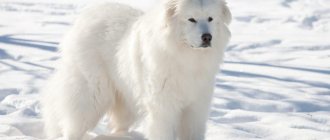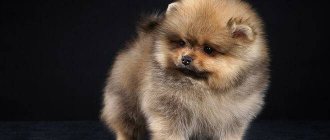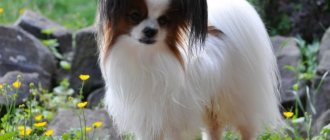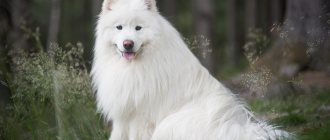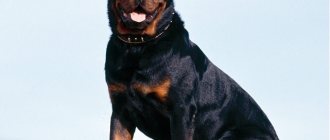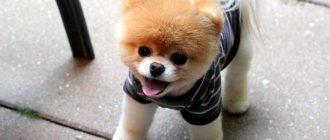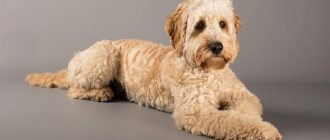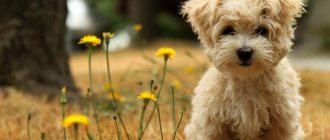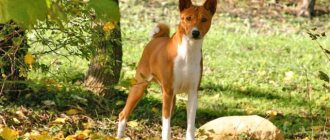Run
Pomchi is a cross between a Chihuahua and a Pomeranian. As you might expect, Pomchi is one of the smallest teddy bears you can find. However, these little guys have one of the brightest personalities of any mixed breed pup!
Chihuahuas have a surprisingly long lifespan, and it's possible that your Pomchi teddy bear will live to be 18 years old or even more.
Pomches are quite delicate and require careful handling, meaning the breed may not be the best choice for families with small children or other, larger pets
Pomches typically have a long, fluffy double coat that requires regular grooming to keep it looking nice and neat. These little dogs come in a variety of colors, from white to all shades of brown, red and gold to pure white.
Shih-Poo
This cross is a cross between a miniature poodle and a shih tzu. Like most Poodle hybrid dogs, Shih-Poos are easy-to-train and highly intelligent creatures that enjoy company and do not like to be left alone for long periods of time.
These little dogs are boisterous bundles of energy, so care should be taken when introducing them to small children and other animals. They are quite active dogs that require a lot of daily exercise.
Shih-poos also need grooming, but to what extent depends on which parent they inherit their coat from. These super sweet teddy bears come in a variety of colors: brown, cream, black, sable, white and red.
You will need to start socializing and training your Shih Poo when he is a puppy to ensure the dog grows up to be confident and happy.
Health problems that Shih-Poos may face include epilepsy and respiratory diseases. Like most small teddy bears, these puppies can live up to 15 years.
How to choose a puppy
Choosing a Pomeranian puppy is a responsible matter that requires some knowledge. Experienced dog breeders can easily identify the best individual in a litter, while those who will have a dog for the first time can make a very serious mistake when choosing, succumbing to pity and buying the smallest puppy, which seems to be crowded among more active and larger brothers and sisters.
This is categorically not recommended, since this dog, at best, will be weak and prone to developing pathologies, and at worst, it will already be sick and require urgent treatment, which, unfortunately, is not always successful. It is also unlikely that this pet will live a long life due to its weakness and health problems.
A good puppy should not be the largest and smallest in the litter. He has clean eyes, nose and ears. He is well-fed, but his stomach is not bloated. A healthy puppy is mobile and active.
The presence of skin parasites, such as lice and fleas, indicates the unscrupulousness of the breeder, from whom it is undesirable to buy a dog. In the future, problems may arise during its maintenance, due to the fact that significant violations were committed during the raising of the puppy before sale, which have a negative impact on the health of the animal.
If possible, you should buy a puppy from a kennel where they can show you the parents. Breeders must provide documents for the animal, and if the puppy is older than 2 months, then a veterinary passport, which will contain notes about vaccinations already done, as well as treatments against parasites.
The bear-type Pomeranian is an attractive pet that has a charming appearance and is able to get along with owners at any pace of life. Contact and sociable, he quickly finds a language with others, including small children. Such a pet will be an ideal companion both for people who prefer an active lifestyle, and for those who mainly spend time in the apartment, taking walks around the house.
Character of the orange
Pomeranian cubs, becoming attached to the owner, become his friend, not his subordinate. With prolonged communication, some dogs adopt the owner’s character traits, usually the most noticeable ones.
The Pomeranian Spitz itself is a very playful and cheerful animal. The dwarf descendants of the German Spitz have exquisite hearing; it is extremely difficult to take them by surprise. They are able to quickly navigate almost any situation. This is a very active and mobile dog.
Pomeranians are smart, they are well brought up and are able to adapt to the rhythm of life and the behavior of the owner. For these dwarf “cubs” the truth is the following statement: a calm owner is a quiet dog, an active owner is a reactive dog. If you raise a puppy from its “young claws,” you can instill in it the desired qualities or develop those traits that seem more acceptable to the owner.
When raising a descendant of a German Spitz, one must not be rude or incontinent. Firmness does not mean anger at the dog or assault. The Pomeranian “bear cub” is a dwarf, but a predator. He must recognize the leadership of a person, love and respect the owner, and not be afraid of him. Of course, a timely reward for a job well done will please this emotional animal.
The Spitz is a very emotional, playful and active dog. You need to raise it based on the method of encouragement and praise, however, when forming bad habits, you can be strict - show that the animal’s behavior has upset you
Pomeranian Spitz
looks like a teddy bear
Main characteristics:
- miniature size and weight, reaching a maximum of three kilograms;
- height at the withers up to twenty-two centimeters;
- beautiful two-layer coat with a dense soft undercoat and hard, long outer fur;
- shaggy tail curving along the back;
- beautiful little muzzle and triangular ears;
- Colors characteristic of this breed: brown, white, orange, black, sandy cream, sable, red, bicolor;
- fluffy and thick wool;
- Very energetic, smart and quick-witted.
Character
easy to train
For those who prefer calm, another problem may arise - the restlessness and increased activity of the orange. True, this is more than compensated for by his perky, cheerful character and friendliness. The dog owner will definitely never be bored! She is ready to frolic and play all day long.
During a walk in rainy weather, your beloved pet turns into a dirty and wet ball of fur. To prevent this, it is better to walk your Spitz in special waterproof overalls.
Pomeranians are fearless. They attack everyone who crosses the threshold of your home. Because of their delusions of grandeur, Pomeranians seem to be formidable giants, much larger in size than any opponent. This should also be taken into account when raising them, otherwise guests will leave with torn trousers.
In order for your pet to be calmer, you need to exercise it and walk it more often.
https://youtube.com/watch?v=xkgQr_iLP0s
Care
- The long, thick coat of Pomeranians should be brushed two to three times a week. During molting, this should be done more often. What makes caring for the fur easier is that it never gets tangled.
- Spitz dogs need their nails trimmed from time to time. This procedure requires knowledge of the structure of the claw. If the pulp was accidentally touched during cutting, it should be disinfected with streptocide powder or hydrogen peroxide.
- Wash the little “bear cubs” once every three months or as needed. After the shower, the orange should be wiped with a towel and dried with a hairdryer.
- It should be borne in mind that the Spitz's neck is surrounded by a fluffy collar. Therefore, in order not to damage the beautiful coat, it is better to walk it not on a metal chain, but on a thin leather collar.
- Dogs of this breed have very weak teeth. Therefore, it is recommended to brush the mouth with dog toothpaste every day to prevent periodontal disease.
- The large eyes of oranges are wiped with a swab soaked in boiled water.
- Spitz can go to the toilet both on the street and at home in the litter box (like cats).
Feeding
preferably after a walk
This dog, which looks so much like a bear cub, has excellent immunity. She has only a few health problems that are typical for all toy breed dogs.
It is very important for Pomeranians to be dewormed and vaccinated on time. It is imperative to follow your pet’s diet and never feed him sweets.
In this case, the dog will live a long time, delighting its owner every day.
Goldendoodle
Intelligent, friendly and affectionate with a moderate activity level and needing a long walk every day, these are companion dogs. They love people and should live in the house, not on the street.
No one will be surprised if it turns out that the prototype of the teddy bear was a goldendoodle puppy with black eyes and fur. The color varies. As a child, he looks like a bear cub that barks for some reason. The lack of undercoat makes it “non-shedding”, but it is necessary to keep the coat in excellent condition and avoid the formation of tangles. A teddy bear haircut not only makes the dog look cuter, but also protects against infections caused by the accumulation of dirt on the face and head. If it is enough for a goldendoodle with straight hair to brush it once a week, then a curly-haired one needs this procedure every day.
Puppies of certain breeds look more like clumsy honey lovers than dogs, but their popularity does not suffer because of this.
- Newfoundland A large, long-haired breed with brown or black coloring. Staining is rarely allowed, but this is by no means considered “dirt” of the breed. A thick undercoat and webbed toes are the hallmarks of a dog as large as a bear.
Basic principles and rules, pros and cons of keeping decorative dogs
The appearance of a dog in the house is always a very significant event, for which it is important to prepare properly. Be sure to remove plants, small and easily destructible objects from the puppy’s access area. This way you will protect your pet from injury.
This way you will protect your pet from injury.
Be sure to remove plants, small and easily destructible objects from the puppy’s access area. This way you will protect your pet from injury.
Don't forget that even decorative dogs love walks and need them. Therefore, litter box-trained puppies must be allowed outside periodically. Otherwise, without sufficient physical activity, the animal’s muscles may atrophy.
We should not forget that decorative dogs, like their large brothers, need training. It’s worth spending time at least learning basic commands (“Ugh!”, “Place!”, “Come to me!”). A disciplined dog will not cause unnecessary trouble to its owners and their neighbors.
The advantages of decorative dogs are as follows:
- small size;
- small daily intake of food;
- the dog can relieve itself in the tray;
- Less time is spent walking.
But there are also disadvantages that the owner of a small barking miracle may encounter:
- dogs can get cold on walks and need clothing;
- Pets of dwarf breeds have fragile bones and an increased tendency to allergies;
- breeding problems may arise;
- decorative dogs are often not suitable for the role of protectors and guards.
Perhaps decorative dogs do not have any practical use for humans, but puppies obtained by crossing purebred and domestic animals are definitely good guards and hunters. An example of this is the dog I had as a child. Her close relatives were Yorkshire terriers, which was easy to understand by their appearance. At the same time, she guarded the house, calmly endured the winter cold, and even hunted rats and other rodents that she came across on the site.
Many people mistakenly think that all small dogs can become good friends for children, but in fact this is not the case. For example, lapdogs and Pekingese are quite selfish and do not tolerate rude treatment, so they can bite a child, wanting to stand up for themselves. Therefore, before purchasing a puppy from a kennel, familiarize yourself with the characteristics of its breed. In addition, you should not take decorative dogs in cases where you are looking for a companion for long hikes, forays into the forest, and the like. Many indoor animals are not adapted to long walks away from home.
Small dogs, unlike large breed animals, are more likely to be intrusive. They require a lot of attention and love from a person, and also do not like to be alone for a long time. Therefore, before you bring a mischievous baby into your home, think about whether you can devote enough time to him.
The breed group of decorative dogs is very diverse and not all of its representatives are good-natured little ones. Some animals have a very selfish and willful character, so it is impossible to do without proper upbringing of the pet. If you really want to have a barking friend in a small apartment, then the easiest option would be to get a representative of a decorative breed that does not take up much space.
Serious mischievous Scotch Terrier
A little devil with a mischievous character and a serious expression on his face is the Scotch Terrier. Of the small dog breeds, this is the most serious, having the ability to be a good companion, an excellent hunter, and a serious protector. Black or fawn dogs have an energetic disposition, they are distrustful of strangers and aggressive towards other animals, and therefore require socialization.
Wire coat requires plucking or trimming 2 times a year and correction before shows.
- real shepherds, even small ones. Their appearance resembles a fox: a cunning, elongated muzzle, protruding ears are combined with a bright red color. Impressive snow-white teeth are almost never used.
Short legs do not prevent the Welsh Corgi from running quickly, accelerating from a standstill, and its good-natured character allows you to fearlessly leave even children with the Welsh Corgi.
Newfoundland
A gentle giant, the Newfoundland is a brave and intelligent working dog. This is primarily a family companion, and will also become a partner for a traveler or tourist.
Huge paws, fluffy fur, round dark eyes, plump cheeks - a Newfoundland puppy can pass for a black bear. Brown and black and white Newfoundlands are also cute. The coat requires constant care; the dog must be bathed 2-4 times a month with special products and combed 3-4 times a week with a stiff-bristled brush. The Newfoundland's haircut should not be radical; its thick coat protects it from cold in winter and from heat in summer.
Alaskan Malamute
Originally bred for tasks such as hunting polar bears or pulling heavy sleds, the Malamute is today a popular dog breed among families and people with active lifestyles.
Between their fluffiness and huge paws and cheeks, these pups look like they'll grow into elegant white and gray bears. The dog needs a bath every 6-8 weeks, and its long coat with a thick undercoat needs to be brushed daily or at least every other day. Thick and moderately hard coat does not require cutting. The color of Malamutes is often gray to black or red.
Pomeranian Spitz
The Pomeranian is a gorgeous little dog that really looks like a teddy bear with thick fluffy fur, tiny ears, a curled tail and a cute teddy bear face. They are confident, playful and intelligent dogs, but can often be aggressive towards other dogs and strangers if they are not socialized.
These tiny dogs require a lot of daily exercise, and you will need to groom your dog at least twice a week, and more often when he sheds. Pomeranians are one of the most popular little furries that people own.
They can be quite expensive to maintain, so take that into account.
Poodle
Boundless energy and a sunny disposition make the Poodle an excellent family dog. No breed has a more developed sense of humor than the poodle.
Poodle puppies, especially the chocolate ones, look like teddy bears. So you can't be sure which one is a poodle and which one is a toy. White, blue and peach poodles are also not uncommon. A dog's fur does not cause allergies, but requires regular care and maintenance. You will have to use not only shampoo, but also wool conditioner. From the age of six weeks you need to accustom your pet to combing. A poodle's haircut can highlight its beauty and grace.
Education and obedience
An active and playful mini-Spitz, he is very smart. Training is an interesting game for him. From the very beginning of being in the house, you should not allow the puppy to do what an adult dog is forbidden to do. Sleeping and playing on the bed can be very dangerous for your Pomeranian - the baby could fall and get hurt. Barking under the table, begging for food from the owner, is a manifestation of poor upbringing.
Raising a dog is a very responsible occupation.
The dog must know that it can only play with and carry its own toys in its mouth. By being persistent in raising your Spitz and making the commands more difficult, you can get a friend for the whole family.
Circus tricks are not at all difficult to learn for a Pomeranian. Good contact with the dog and understanding of the pet’s wishes will provide the owner with motivation to learn new commands.
The Pomeranian's stubbornness and loud barking can be stopped with an offer to play. All family members must be equally persistent in their demands, otherwise the dog will understand and will continue to violate prohibitions, causing the indignation of the owners.
Dog handlers consider the Spitz to be an easily trained dog. With a competent approach and love for the bear cub, you can receive diplomas and control the dog at any, even noisy, events. Obedience and following commands during walks are the main things a Mini Spitz is capable of.
Rabbit dachshund
Dwarf dachshunds, also called rabbit dachshunds, have three coat varieties: smooth-haired, long-haired and wire-haired. All of them are united by a healthy, stress-resistant nervous system. The dog is absolutely not aggressive, but at the same time brave and cautious.
Representatives of the breed do not tolerate rudeness and pressure; competent dog handlers take this into account when drawing up an individual training plan. Another striking feature of rabbit dachshunds is their overly developed sense of ownership.
Moreover, this manifests itself not only in relation to the beloved owner, but also toys, sleeping place
The owner of a rabbit dachshund must develop such qualities as affection, attention, patience, consistency
The dog will defend its right to make independent decisions, which from the outside may look like an unwillingness to be trained. Having received the owner's permission, dachshunds are happy to play with other dogs and get to know their owners.
The bravest dog breed
German Shepherd
The bravest dog breed is the German Shepherd. Reliable and devoted human assistants, the appearance of which the world owes to the German breeder Captain Max von Stefanitz, are universal.
Max von Stephanitz
They perform guard and search duties, herd sheep, and are first-class bodyguards with equal success. In the event of aggression from a perceived enemy, vigilant dogs show amazing composure, toughness and fearlessness. There are legends about the courage of the masterpiece of German cynology, confirmed by real stories. Thus, Nemo A534, who took part in the battles of the Vietnam War in 1966, became an example of heroism. During one of the battles, a seriously wounded shepherd dog, bleeding, defended its owner from opponents with its body. Even when reinforcements arrived, the devoted dog refused to budge for a long time.
The Bullmastiff, Rottweiler, Caucasian Shepherd, Cane Corso, Fox Terrier, West Siberian Laika and German Shepherd are usually considered to be the bravest dog breeds. However, this classification is approximate, because the behavior of an animal depends not only on its genetic predisposition, but also on skillful upbringing and proper training, which directs innate traits in the right direction.
West Siberian Laika
West Siberian Laika
The West Siberian Laika, bred in the 20s of the 20th century in the vast North and Siberia, is one of four varieties of hunting huskies. Cynologists consider the ancestors of modern representatives of this primitive breed to be the oldest on the planet. Pointy-eared dogs sport a strong back, wedge-shaped head, thick undercoat and muscular limbs, indicating their close relationship with the wolf.
From their wild ancestor, the animals also inherited extraordinary courage, which helps in working with the beast. Bear cub huskies have exceptional courage. They must not only find the clubfoot and make a painful grip (by the gacha or hind legs), but also hold him until the owner arrives. Fearless four-legged hunters are sometimes so carried away by baiting that they forget about their own safety and die under the blows of the powerful paws and teeth of a huge predator.
Dogs that look more like bears
Dogs that look like bear cubs are especially attractive in the eyes of people. Often, when buying a pet, future owners do not give preference to any specific breed, but choose solely based on external features.
Based on such parameters, dogs with one common characteristic can be divided into a separate group - visual resemblance to a bear.
Basic breed qualities
Many dogs have unique features that make them resemble various wild animals - wolves, foxes, lions and even horses. But pets that evoke teddy bears are endowed with a special charm.
Large and medium-sized bear-like breeds usually have an ancient history of origin. Most of them are difficult to keep in an apartment (due to their size or the difficulty of creating optimal conditions), but in a private house with a plot of land such a dog will be very comfortable.
Rich fur, which provides the main resemblance to a clubfooted wild animal, will protect the animals from any cold weather.
Such dogs have acquired miniature sizes thanks to selection. If in past centuries their ancestors were watchmen, hunters or shepherds, now they are exclusively decorative pets, and also wonderful companions.
Popular breeds of bear dogs
All bear-like breeds have different characteristics and require certain conditions of detention, and each of them is charming in its own way. But dogs that look especially like bear cubs are worthy of special mention.
Newfoundland
Representatives of one of the largest and most ancient breeds are distinguished by their intimidating appearance, impressive size, but kind character. At the withers they reach 66-71 cm and weigh 70 kg.
https://youtube.com/watch?v=1y3y55RokUU
The resemblance to a bear is given not only by the abundant fur and dimensions, but also by the shape of the dog’s ears - they are small and fit tightly to the head. The skull is large, rounded and wide, the muzzle is short. The coat is abundant and coarse, with a thick and soft undercoat. Dark colors (black, brown, etc.).
The build of the Newfoundland breed is balanced, massive, and strong. The huge advantages of a dog are its friendliness, calmness, intelligence, and patience. But caring for it is somewhat problematic: its considerable dimensions require a lot of space, and the fur requires close attention.
Molting continues all year round. Obvious disadvantages include excessive salivation and a short lifespan (on average 10 years).
Due to passivity, such dogs often suffer from obesity, so they need at least a little activity and a strict diet.
Alaskan Malamute
Hardy and strong sled dogs have a good disposition. Their modern purpose is as companions and family pets. However, to this day, the working qualities of Malamutes are manifested in extraordinary assertiveness and stubbornness.
: Description of the Alaskan Malamute breed
If the dog's build is more like a wolf, then the lush fur adds a resemblance to a bear, especially in puppyhood. The animal's thick fur is designed for the harsh arctic climate, so owners have to use a brush often, especially during the molting period.
The similarity is added by the large head and wide muzzle. And the large paws, which prevent the animal from drowning in the snow, are similar in structure to those of a bear.
The plush appearance makes people want to buy a pet, but stubbornness and some difficulties in maintenance, unfortunately, sometimes make owners regret their choice.
Chow chow
In relation to this breed, epithets about the bear are used most often. Although the Chinese call the dog a shaggy lion (this is how the name Chow Chow is translated), its appearance is more like a bear.
The working purpose of the breed is indicated by a strong and powerful build, strong limbs, and a wide chest. The dog's weight reaches 20-32 kg (males are noticeably larger), height 46-56 cm. The standard allows several colors: black, blue, red, reddish, cinnamon.
The peculiarity of the Chow Chow is that behind its charming appearance lies a domineering, proud and stubborn disposition. Initially, the breed was intended for fighting and baiting, hence its complex character.
Attractive appearance
While dog breeders were experimenting with the breed, they fought to reduce the animal’s height and weight. But then they decided that this was not enough - aristocracy and good looks wouldn’t hurt either. In the process of breed selection, attention was paid to 2 points:
- miniaturization;
- imparting “bearness”, that is, fluffiness of the coat and sophistication of colors.
The result was a cute descendant of the German Spitz - a little “bear” with a very lively character. His round-eyed face is full of charm. Small ears on a rounded head and a flattened muzzle make the animal look extremely teddy-bear-like. The Pomeranian has a strong body, the hair literally stands on end, which makes the paws look very fluffy. The coat looks in such a way that the dog seems surrounded by a certain aura. Height and weight indicators of the bear-type Spitz:
- height 22 cm (at the withers);
- weight 3.5 kg.
There are representatives of the breed with slightly larger dimensions. But mostly these are miniature dogs, and they “gain” size due to their rich fur. According to external data (the structure of the muzzle), three types of Pomeranian Spitz are distinguished:
- bearish type;
- fox type;
- toy type.
Bear-type Spitz bears are very reminiscent of miniature bear cubs, both in the thickness of their fur and the shape of their heads, paws, and ears. They are extremely cute - funny and serious at the same time.
In terms of structure, the “adult” state is achieved by “bears” by one year. At this age, you can determine the type of Pomeranian Spitz. The “bear cubs” have eyes close to the nose. Plump cheeks, densely covered with fluffy fur, form the “bear” appearance. “Fox cubs” have a correspondingly more elongated muzzle. Toy Pomeranian dogs have a flattened face and wide-set eyes. The color scheme of the fur of animals is very diverse:
- two-flowered;
- sable color;
- pure black or with tan marks;
- bluish fawn;
- pure white;
- cream;
- orange;
- chocolate.
Popular breeds
There are many dogs that resemble bears in their appearance. But those breeds whose similarities with them are very great deserve special attention.
Alaskan Malamute
The Alaskan Malamute is a sled dog, strong and resilient. He has a good disposition and a friendly character. Its thick coat helps it easily withstand the harsh Arctic climate. General description of the breed:
- the head is large, wide;
- the paws are massive, thanks to which the dog does not drown in thick snow;
- the color is varied, it can be monochromatic, gray and white, or two-color (usually a combination of a snowy shade with a red, gray or black tone);
- adult height is from 58 to 65 cm, weight is from 34 to 38 kg;
- character – very kind, flexible;
- attitude towards children - a Malamute can play for hours with children and other household members, it is a faithful and devoted friend, a full-fledged member of the family.
The Alaskan Malamute is a dog with an ideal character and a soul filled with kindness and responsiveness. The Alaskan Malamute, thanks to its cute, toy appearance, is a desirable breed for many. But it is extremely rare for them to be kept at home.
In particular, the coat requires a lot of attention during the molting period: it needs to be combed daily with a special brush.
Tibetan mastiff
Looking at a dog with impressive size, it is difficult to imagine that she has a very kind and affectionate disposition. Breed Features:
An adult mastiff reaches a weight of 45 to 75 kg; there are individuals weighing up to 90 kg. Considering the size of the breed, it is completely unsuitable for living in an apartment
She needs large outdoor enclosures. The Mastiff is active from morning to evening and constantly requires proper attention, games and a variety of physical activity. The dog has a sharp mind, stubbornness and independence. The breed is not recommended for families with small children. Although the dog loves children very much, he can perceive some of their harmless but careless actions quite aggressively.
The mastiff's coat is long, thick and very heavy. The color is different - black, brown with brown accents, gray, red with a golden tint.
Akita Inu
Of all the big bear-like dogs, the Akita Inu is distinguished by the fact that its coat is not long and shaggy, but very lush and rather coarse, with a soft undercoat. The history of this Japanese breed began more than 8,000 years ago.
Akita Inu is a large dog. The height of an adult reaches 64-75 cm, weight - from 35 to 60 kg. Brief information about the breed:
- The main advantage of the breed is its loyalty and devotion.
- The dog's character is lively and energetic. This is a kind and flexible dog, tireless and playful.
- The dog's temperament is calm and calm in an oriental style. The dog behaves warily and reservedly with strangers, without showing aggression towards them.
- Akita Inu barks quite rarely; instead, she can utter other various sounds similar to snorting, grunting, and growling.
- Coat color – white, brindle, red.
When getting a dog from Japan, you need to take into account that its maintenance will be expensive. In addition, the breed is not suitable for those who want to find a calm dog. Akita Inu, due to its innate activity, will require a lot of attention, trying to involve household members in its games.
Chow chow panda
When mentioning a bear dog, most people associate it with the Chow Chow breed. This Chinese bear dog is known in its homeland as a shaggy lion - this is how the name of the breed is translated. Characteristics of Chow Chow:
- The height of an adult dog is from 46 to 56 cm. Weight is from 20 to 32 kg.
- Coat color – blue, cream, black, red. The coat can be long or short.
- The character is strong-willed, independent, which is why the pet must be carefully raised. The Chow Chow tends to show its superiority over other dogs, often showing aggression towards them. The attitude towards strangers is wary; if the dog feels a threat to its owner from a stranger, it will quickly fight back.
- The attitude towards children is cool. The Chow Chow can play with children, but will not tolerate their excessive affection. Therefore, it is not recommended to have a dog in a family where there are children under 14 years of age.
- The original purpose of the breed is fighting, guarding, and hunting.
Boston Terrier
Descendant of the French Bulldog, what can be said without knowing the historical selection process. The dogs have similar features - large muscles, voluminous hips (like all fighting breeds), a wide upturned muzzle, a large head, and triangular large ears. The coat is smooth, colors are brindle, black and white. They are large in size - 38-43 cm. They can weigh up to 6 kg, 9-13 kg.
Now the fighting past of their ancestors is forgotten, the breed is exclusively decorative. Bostons love children and can play tirelessly. But during training they often become stubborn and try to dominate. They need a good training program for all muscle groups and proper training.
Dog breeds similar to bears
All dogs are beautiful, regardless of their breed. However, due to its appearance, some of them are especially gentle. It can take us back to childhood and remind us to curl up with our favorite teddy bear. Teddy bear dogs are dogs with fluffy, lush, and velvety fur that mimics their feel and appearance. You can take whatever it takes to not move and hug them forever. Often the most teddy bear-like state is when they are puppies, and their fur remains soft and soft as they grow. Many, however, also maintain this appearance into adulthood.
If you're looking at this list of dog breeds because you want to adopt a dog that looks like a teddy bear, then keep in mind that you should adopt a dog that fits your lifestyle. Many of these breeds have coatings that require a lot of maintenance to keep them clean and hygienic. They may require more baths than other dogs and loss is a key issue, especially for a proud home. Tangles, dead hair, excess dirt and more are some of the negative factors, but the spread of disease is another. Additionally, you should not adopt a dog solely based on its appearance. You need to make sure you can handle the responsibilities of administering the dog and also be aware that breeding breeds are not always the best option. Not to mention, adopting a sheltered animal helps find homes for otherwise neglected dogs.
Now that you've spent some time considering dog ownership (or if you just want to look at cute pictures of dogs that look like bears), you can continue reading about the world's most bear breeds.
Obedient Border Terrier
The character of the Border Terrier is characterized by some duality. On the hunt, he is a ruthless and passionate dog, but at home he is an affectionate, friendly, loving pet. Many representatives of this breed can smile, exposing their teeth.
This sweet-natured dog is used in Western medical settings as a “therapy animal.” Border Terrier owners visit nursing homes and hospitals with their pets, providing psychological support to sick people.
Alaskan Klee Kai - relatives of the husky
The Alaskan Klee Kai, like all huskies, is beautiful in appearance, smart and independent. Unlike the stubborn Siberian Huskies, their miniature counterparts are more cat-like in behavior. They are affectionate towards their owner and even wash their faces with characteristic movements of their paws.
Another incredible ability of the Alaskan Klee Kai is the ability to make sounds similar to human speech. A set of guttural, howling, gurgling sounds is really similar to a conversation, so communicating with a pet can bring real pleasure.
4.9
/
5
(
9
votes)
A small, very cute dog that looks like a little bear is a Pomeranian Spitz. Thanks to its unique appearance and interesting color of thick fur, this mini-bear is one of the most popular breeds among amateur dog breeders. Photos of this animal with its childishly naive eyes and touching muzzle cannot but evoke tenderness even in those people who are not particularly fond of dogs.
Features of care
A dog that looks like a bear needs a large enclosure and constant walking. To maintain good shape, they vitally need moderate physical activity. They should also be given the opportunity to swim and play in the water at least occasionally. For them it is like a native element.
Newfoundland coat care is standard. 1-2 brushings per week and bathing when soiled are enough. This breed sheds almost throughout the year and therefore “matts” often form in their coat. To prevent this, in addition to basic combing, the dog is combed daily with a special brush with stiff bristles.
The diet of this breed must be high in calories and strictly balanced. Large body weight requires large amounts of vitamins and minerals
When compiling a diet, the age, weight and health status of the animal must be taken into account. For more specific recommendations, it is worth visiting a veterinarian
Spitz colors
To seriously engage in dog breeding, you need to carefully study the pedigree of your ancestors, taking into account all the shades that are found in the genetic branch.
Features of the main Spitz colors:
- A white puppy is allowed for exhibitions if there are no other shades. Specks with a yellow tone on the ears or cream spots are unacceptable.
- The sable shade can be with gray, red and cream undercoat. With each month the dog grows older, the color changes. At exhibitions, orange color with uniform saturation is especially preferred.
- Red dogs without extraneous inclusions of dark color are welcome at exhibitions. This color is characterized by light shades at the end of the tail, muzzle, ears and legs.
- The dog's cream color can be rich or cool almost white. These representatives of the breed have light colored noses and eyes. These Spitz dogs are often purchased as apartment pets.
- The zone-gray or wolf color of the Spitz is quite unusual. The silver-gray fur is similar to that of a wolf. Black color can be seen at the tips of the guard hairs and as the undercoat.
- Party color, according to the standard, assumes the dominance of a white tone with the addition of red, brown or black spots, which should be evenly distributed over the body.
- Black and black and tan oranges have all dark parts without light inclusions. Red and fawn markings may be located under the eyes, on the face, chest, legs and tail.
- A brown dog should be evenly colored.
- The dog with a blue tint is a type of gray breed. Dogs with a bear face and this color are quite valuable.
A gray puppy with a blue tint is an expensive dog breed
From the descriptions it is clear what a dog of this breed looks like and what features it has. Before purchasing a puppy, you should think carefully about which color you like best and for what purpose the dog is needed.
Chow chow
If you have always wanted a bear cub, but could not afford one, then a chow chow will help your dream come true. The unusual appearance of the dog is the first thing that catches your eye: the lion's mane, the serious expression of the muzzle and the purple tongue make it possible to distinguish this breed from others even to those who know little about dogs. But behind the sweet appearance hides a very independent and stubborn character. Chow Chows are full of dignity and behave accordingly. They will choose only one person as a leader, and they will do it themselves; it will be impossible to convince the pet. Therefore, it is recommended to take this dog into the home as a puppy and raise it only to one person. The breed is absolutely not suitable for beginners; the owner must have extensive experience in raising serious dogs. But he won’t wait for special manifestations of love either - chow-chows are stingy with feelings, but at the same time they are loyal and will always be there.
Chow Chows are clean and do not like walking in wet weather.
But despite the complexity of the character, the dog continues to remain cute in appearance.
Irish Setter
A very sociable dog that does not want and cannot tolerate loneliness. The charming appearance of an aristocrat, infinitely intelligent eyes and the almost complete absence of smell - all these qualities are very fond of breeders. The setter sheds extremely rarely and sparingly; the undercoat does not fly around the apartment and does not remain on clothes or furniture upholstery.
But the setter's coat requires the most careful care with special washing products, daily combing and, in some cases, professional grooming. If you don’t do any of this, you will soon discover quite a lot of tangles, a loss of shine and the overall aesthetic appeal of the dog.
Initially, the Irish Setter was a hunting dog, but now it is more often seen as a companion dog, a family friend. But there is no escape from instincts. If a setter sees a pond, he will forget about everything and dive there in 9 cases out of 10.
Representatives of the breed have more than enough energy, so walks should be very prolonged in time and contain as many activities as possible. A red fluffy dog will quickly become your personal antidepressant. It’s hard to be depressed for long when you’re around a cheerful setter!
Bichon Frize
With its curly white fur and prominent button eyes, the Bichon Frize resembles a plush toy. Only unlike her, this is a very active and cheerful pet. Bichon Frizes are very sociable and friendly, making them suitable for large families - there are more playmates. They will fit perfectly into any housing dimensions, having a height of up to 30 cm and a weight of up to 3 kg.
Miniature dogs easily learn not only basic, but also quite complex commands, which is why Bichons can often be found in the circus arena
Bichons are good watchdogs. They have a ringing voice, which they will gladly use if they hear a stranger at the door of the house. But dogs don’t like being left alone at all. Returning after a day of work, you can see from the doorway what your pet was doing to amuse himself, and the neighbors will prove that he definitely missed you, since they listened to his barking all day.
Cavalier King Charles Spaniel
A cute fidget can become your best friend. Representatives of this breed do not have sudden mood swings, they are affectionate and mischievous. But dogs require the constant presence of a person - otherwise the “gentleman” begins to get bored and play dirty tricks.
In extreme cases, if work doesn’t let you go, but you don’t want to part with your pet, the owners buy a second Cavalier King Charles Spaniel. Together, it is easier for dogs to survive the absence of their beloved owner without consequences.
Representatives of a rare breed are true extroverts. They are sincerely happy to communicate and are ready to see a friend in every passerby. Dogs love touch, so be prepared for constant stroking, scratching and cuddling with or without reason. This is an excellent quality for families with small children - the “gentleman” is not annoyed by the obsessive hugs of children, he is only happy with them.
